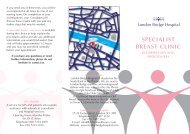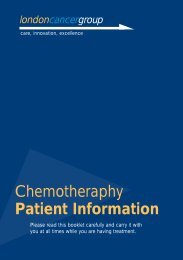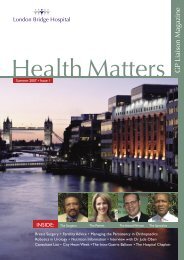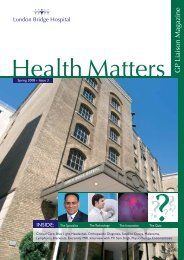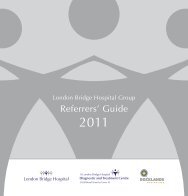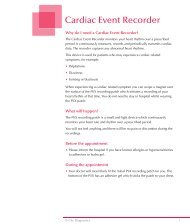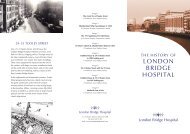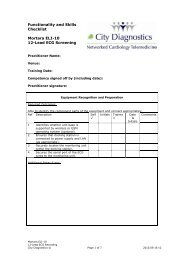Health Matters - London Bridge Hospital
Health Matters - London Bridge Hospital
Health Matters - London Bridge Hospital
- No tags were found...
Create successful ePaper yourself
Turn your PDF publications into a flip-book with our unique Google optimized e-Paper software.
Seminar – Thursday 7th February 2008Atrial Fibrillation (AF) is the mostcommon cardiac arrhythmiaSeminarFigure 1The ModernManagement of AFSeminar for GPs at <strong>London</strong> <strong>Bridge</strong> <strong>Hospital</strong> with LiveCase DemonstrationProgramme - 7th February 2008Who should have Warfarin?Who should be cardioverted?Is there a cure?Who should use treatmentand what should it be?All of these common questions willbe answered for you at our seminar.AF causes a marked reduction in cardiac performance leadingto breathlessness, syncope and disabling palpitations. It is alsostrongly associated with stroke, a complication which can beavoided with proper use of oral anticoagulants. Despite itsimportance, AF remains poorly understood and there arewide variations in how it is managed by clinicians.Over the past 10 years, there have been dramatic advancesin treatments available for AF, in particular, the developmentof percutaneous catheter ablation. In the past, patients wereconsidered untreatable and the disease was allowed to followits own natural course. However, more recently there hasbeen a drive by many cardiologists to restore and maintainsinus rhythm over the long-term. In parallel with this, however,there have been claims from other cardiologists that this isthe wrong approach, claiming that AF should be managedconservatively, using just Warfarin to prevent stroke, anddrugs such as Digoxin to keep the patient’s ventricular ratecontrolled.A consequence of this ongoing debate is that many nonspecialistsare now confused and uncertain how to best managetheir AF patients. This seminar hopes to clarify AF managementfor GPs by reviewing these controversies and offering simpleguidelines. In addition, a live AF ablation case will be performed(see figure1) which we hope will demystify this procedure anddemonstrate that, for appropriate patients, it is a safe andeffective way of treating this common condition.Figure 1: Left atrium of a patient undergoing AF ablation. Theimage has been reconstructed from a CT scan and is used toguide the ablation catheter around the chamber, so that ablationcan be delivered at the pulmonary veins, the usual source of AF.12:00 Welcome Mark Earley12:00 - 12:20 AF – is it safe to ignore orshould we try and restoresinus rhythm in everyone?12:20 - 12:40 A quick guide to restoringand maintaining sinusrhythmMark EarleySimon Sporton12:40 - 13:00 Warfarin – who needs it? Mark Earley13:00 - 13:15 Catheter ablation of AF –the patient journeyClaire Chitty13:15 - 13:20 Introduction of case Richard Schilling13:20 - 14:00 Lunch14:00 - 16:00 Ablation of paroxysmal AF.Live case performed at<strong>London</strong> <strong>Bridge</strong> <strong>Hospital</strong>by Dr Richard SchillingDuring case Catheterablation of AF: strategyand how it is done16:00 Close of meetingSpeakersClaire ChittyMark EarleyArrhythmia Nurse Specialist,<strong>London</strong> <strong>Bridge</strong> <strong>Hospital</strong>Simon SportonConsultant Cardiologist, St Bartholomew’s<strong>Hospital</strong> and <strong>London</strong> <strong>Bridge</strong> <strong>Hospital</strong>Richard Schilling Consultant Cardiologist, St Bartholomew’s<strong>Hospital</strong> and <strong>London</strong> <strong>Bridge</strong> <strong>Hospital</strong>Simon SportonConsultant Cardiologist, St Bartholomew’s<strong>Hospital</strong> and <strong>London</strong> <strong>Bridge</strong> <strong>Hospital</strong>5



